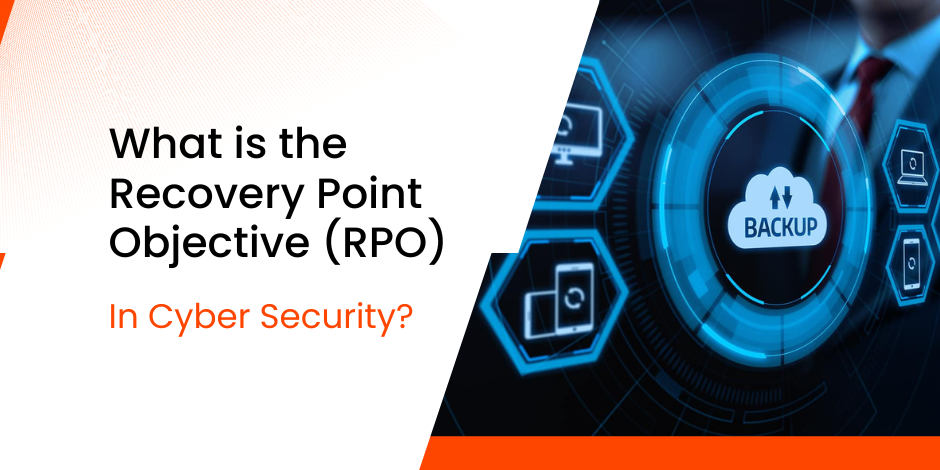What is Recovery Point Objective (RPO) in Cyber Security?

Stay Informed With Our Weekly Newsletter
Receive crucial updates on the ever-evolving landscape of technology and innovation.
In the current era of digitisation, cyber security is a critical concern for both businesses and individuals.
Amid the escalating frequency and sophistication of cyber attacks, there is a growing imperative for robust measures to safeguard sensitive data and systems.
For perspective, the Disaster Recovery Solutions market has experienced substantial growth, attaining a valuation of USD 4521.43 million in 2021 and is anticipated to reach USD 27967.6 million by 2027.
One such measure is the Recovery Point Objective (RPO), a key concept in disaster recovery planning that plays a vital role in ensuring the resilience of an organisation’s IT infrastructure.
We explain the details of RPO, examining its definition, importance, implementation, and future in the rapidly evolving realm of cyber security.
Defining the Recovery Point Objective

The Recovery Point Objective is a metric that determines the maximum amount of data loss acceptable to an organisation in the event of a cyber security incident or system failure.
Essentially, it defines the point in time to which data must be recovered for business operations to resume effectively. RPO is closely linked to data backup strategies and is a critical component of disaster recovery planning.
The importance of Recovery Point Objective (RPO) in cyber security
Recovery Point Objective is of utmost importance, as it directly impacts the ability of an organisation to recover its data and resume operations following an incident.
By setting appropriate RPO targets, businesses can ensure that they have recent and accurate data available for recovery, thereby minimising potential data loss and its associated consequences.
This is particularly crucial for organisations that handle sensitive information, such as financial institutions, healthcare providers, and government agencies.
Imagine a scenario where a financial institution experiences a cyber security breach that compromises their customer data.
Without a well-defined RPO, the organisation may struggle to recover the most recent data, leading to significant financial losses and reputational damage.
On the other hand, if the institution has a robust RPO strategy in place, it can quickly restore the data to a point just before the incident, minimising the impact on its operations and customers.
The role of RPO in disaster recovery planning
Disaster recovery planning is a comprehensive approach to ensuring business continuity in the face of unforeseen events, including cyber attacks, natural disasters, and system failures.
Recovery Point Objective plays a crucial role in this process, shaping the data backup strategies that organisations adopt to protect and recover their critical assets.
How RPO influences data backup strategies
An organisation’s RPO directly influences the frequency of data backups.
A shorter RPO requires more frequent backups, which means that data loss will be minimal in the event of a cyber security incident or system failure.
Conversely, a longer Recovery Point Objective may result in a higher risk of data loss and could significantly impact an organisation’s ability to recover critical information.
Therefore, determining an appropriate RPO is essential in determining the frequency and scope of data backups.
Balancing RPO with Recovery Time Objective (RTO)
While the Recovery Point Objective focuses on the maximum acceptable data loss, the Recovery Time Objective (RTO) determines the maximum tolerable downtime for an organisation during a disruption.
RPO and RTO are interrelated, as RTO sets the time frame within which data must be restored following an incident.
Balancing RPO and RTO ensures that organisations have an efficient and effective disaster recovery plan that minimises both data loss and downtime.
Implementing RPO in your organisation

Implementing RPO in your organisation requires careful planning and consideration of various factors.
By following a systematic approach, you can determine and implement a Recovery Point Objective that suits your organisation’s needs.
Steps to determine your RPO
The first step in implementing RPO is to assess your organisation’s data requirements and identify the critical data that must be protected.
The importance of proper risk identification cannot be overstated, as 31% of executives highlighted their primary cyber security challenge as the improper identification of key risks.
To achieve this, gain a comprehensive understanding of the dependencies and relationships among various data sets and systems.
Next, assess your existing data backup processes, align them with industry best practices, and pinpoint potential areas for enhancement.
Lastly, collaborate with key stakeholders and decision-makers to establish fitting RPO targets for your organisation.
Common challenges in setting an RPO
Setting an RPO can be challenging due to various factors, including budget constraints, limited resources, and the complexity of modern IT infrastructures.
Organisations need to strike a balance between the desired RPO targets and the cost and effort required to achieve them.
Additionally, the rapid growth of data volumes and the increasing prevalence of cloud-based systems pose further challenges in implementing an effective RPO strategy.
Overcoming these challenges requires careful planning, continuous assessment, and a willingness to adapt to evolving technologies and threats.
The future of RPO in cyber security

Several emerging trends are shaping the future of RPO in cyber security.
The proliferation of Internet of Things (IoT) devices, the increasing adoption of cloud services, and the growing reliance on artificial intelligence (AI) and machine learning (ML) technologies all introduce new challenges and opportunities for RPO implementation.
Organisations must stay abreast of these trends and ensure that their RPO strategies align with the evolving threat landscape.
In conclusion
Understanding the Recovery Point Objective is essential in developing a comprehensive and effective cyber security strategy.
Whether it is protecting critical data, ensuring timely recovery, or adapting to emerging threats, RPO plays a central role in ensuring business continuity in the face of cyber security incidents.
Improve or upskill your cyber security proficiency and actively contribute to securing digital assets by exploring The Institute of Data’s specialised Cyber Security program.
If you’re seeking personalised guidance on forging a career path in cyber security, schedule a complimentary career consultation with our team of experts to receive tailored advice and insights on how our program can help you achieve your goals.




